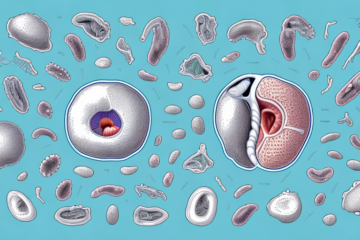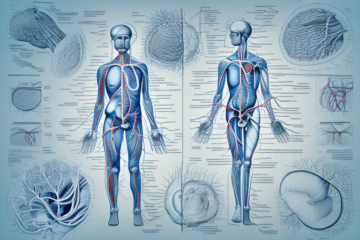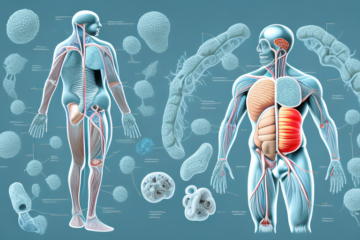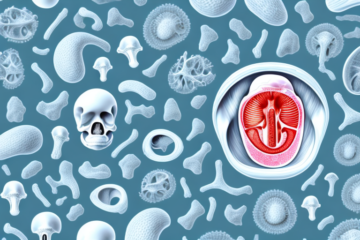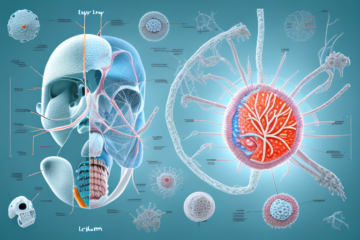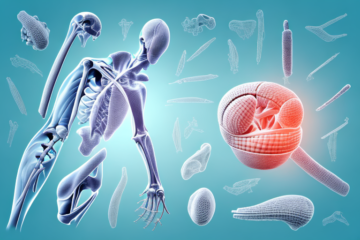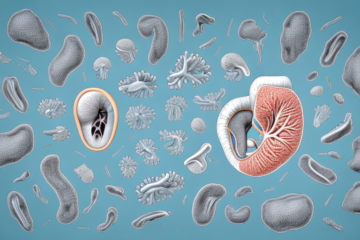Subcutaneous tissue is a layer of fat and connective tissue that lies beneath the skin. It is one of the body’s most important tissues, serving many functions beyond just insulation and padding. In this article, we will take a closer look at the anatomy and functions of subcutaneous tissue, as well as its role in wound healing, energy homeostasis, and body contouring.
Understanding the Subcutaneous Tissue: An Overview
The subcutaneous tissue is the layer of fatty tissue that is located directly beneath the skin. It is the deepest layer of skin, and it serves as a protective layer between the skin and the underlying organs and bones. This layer helps to regulate body temperature, store energy, and provide cushioning for the body’s internal organs. It is also responsible for the transport of waste and nutrients throughout the body.
One of the key functions of the subcutaneous tissue is to provide insulation for the body. This layer of fat helps to keep the body warm by trapping heat and preventing it from escaping. In addition, the subcutaneous tissue also plays a role in the body’s immune system. It contains immune cells that help to fight off infections and diseases.
Changes in the subcutaneous tissue can also be an indicator of certain health conditions. For example, a decrease in subcutaneous fat can be a sign of malnutrition or an underlying medical condition such as diabetes. On the other hand, an increase in subcutaneous fat can be a risk factor for obesity and related health issues such as heart disease and high blood pressure.
The Anatomy of Subcutaneous Tissue: Layers and Composition
The subcutaneous tissue is composed of several layers, including adipose tissue, fibrous tissue, and blood and lymphatic vessels. Adipose tissue is the most abundant component of the subcutaneous tissue and is responsible for storing energy in the form of fat. Fibrous tissue provides connective support to the subcutaneous layer and helps to keep the fat cells in place. Blood and lymphatic vessels are also present in the subcutaneous tissue and are responsible for transporting oxygen and nutrients to the surrounding tissues.
In addition to its structural and functional roles, the subcutaneous tissue also plays an important role in regulating body temperature. The adipose tissue in the subcutaneous layer acts as an insulator, helping to maintain a stable body temperature by trapping heat and preventing heat loss. This is particularly important in cold environments, where the body needs to conserve heat to maintain its core temperature.
Functions of Subcutaneous Tissue: A Closer Look
Subcutaneous tissue serves many important functions in the body, including insulation, cushioning, and energy storage. The subcutaneous fat layer provides insulation to the body, which helps to regulate the body’s internal temperature. It also acts as a cushion, protecting the body’s internal organs from injury. In addition, subcutaneous tissue stores energy in the form of fat and releases it when the body demands extra energy.
Recent studies have also shown that subcutaneous tissue plays a role in the immune system. It contains immune cells that help to fight off infections and diseases. This means that subcutaneous tissue not only provides physical protection to the body, but also helps to defend it against harmful pathogens. Further research is being conducted to better understand the extent of subcutaneous tissue’s involvement in the immune system.
Development of Subcutaneous Tissue in Humans
Subcutaneous tissue develops in humans during fetal development and continues to grow and change throughout childhood and adolescence. The amount of subcutaneous tissue in the body varies depending on age, gender, and health status. As we age, the amount of subcutaneous fat in the body tends to increase, leading to changes in body composition and increased risk for certain health conditions.
Subcutaneous tissue is an important component of the body’s overall structure and function. It provides insulation, cushioning, and support for the skin and underlying tissues. In addition, subcutaneous fat serves as an energy reserve and plays a role in hormone regulation. However, excessive accumulation of subcutaneous fat can lead to obesity and related health problems such as diabetes, heart disease, and certain types of cancer. Therefore, maintaining a healthy level of subcutaneous fat through proper diet and exercise is crucial for overall health and well-being.
Differences in Subcutaneous Tissue Across Species
The amount and type of subcutaneous tissue in the body can vary widely among different species. For example, some animals, such as polar bears, have a thick layer of subcutaneous fat that provides insulation in cold environments. Other animals, such as whales, have a thick layer of blubber in place of subcutaneous fat. Understanding these differences in subcutaneous tissue can help scientists better understand the biology and physiology of different animal species.
In addition to insulation, subcutaneous tissue can also serve other important functions in different species. For example, in some animals, such as camels, subcutaneous fat can be used as a source of energy and water during long periods of drought. In other species, such as elephants, subcutaneous tissue can help to protect vital organs from injury.
Furthermore, differences in subcutaneous tissue can also have implications for human health. For instance, individuals with a higher amount of subcutaneous fat may be at a greater risk for certain health conditions, such as diabetes and heart disease. Understanding the role of subcutaneous tissue in different species can therefore provide valuable insights into the mechanisms underlying these diseases and potential treatments.
Types of Fat Cells Found in Subcutaneous Tissue
There are two main types of fat cells found in subcutaneous tissue: white fat cells and brown fat cells. White fat cells are the most common type of fat cells in the body and are responsible for storing energy in the form of fat. Brown fat cells, on the other hand, are less abundant and are responsible for generating heat in the body. They are found mostly in newborns and hibernating animals, as they play a role in regulating body temperature.
In addition to white and brown fat cells, there is also a third type of fat cell called beige fat cells. These cells are similar to brown fat cells in that they can generate heat, but they are found in white fat tissue and can be activated through exercise or exposure to cold temperatures. This makes them a potential target for weight loss and metabolic health.
Research has also shown that the distribution of fat cells in the body can have an impact on health. For example, having a higher proportion of visceral fat cells (fat cells located around organs in the abdomen) has been linked to an increased risk of metabolic disorders such as type 2 diabetes and cardiovascular disease. Understanding the different types and distribution of fat cells in the body can help in developing strategies for weight management and improving overall health.
The Role of Subcutaneous Tissue in Energy Homeostasis
Subcutaneous tissue plays an important role in the body’s energy homeostasis. When energy supplies are plentiful, the body stores excess energy as fat in subcutaneous tissue. When energy demands are high, the body can draw on these fat stores for energy. This helps to maintain a stable energy balance in the body and prevent under- or overconsumption of calories.
Recent research has also shown that subcutaneous tissue plays a role in regulating insulin sensitivity. Adipose tissue, which is found in subcutaneous tissue, secretes hormones and cytokines that can affect insulin signaling and glucose metabolism. This means that subcutaneous fat may have a protective effect against insulin resistance and type 2 diabetes.
However, excessive accumulation of subcutaneous fat can also have negative health consequences. Studies have linked high levels of subcutaneous fat to an increased risk of cardiovascular disease, metabolic syndrome, and certain types of cancer. Therefore, it is important to maintain a healthy balance of subcutaneous fat in the body through a balanced diet and regular exercise.
How Subcutaneous Tissue Plays a Role in Wound Healing
Subcutaneous tissue also plays an important role in the body’s wound healing process. When the skin is damaged, subcutaneous tissue helps to supply nutrients and oxygen to the damaged tissues, and also provides a scaffold for the growth of new tissue. In addition, subcutaneous tissue provides a layer of insulation and cushioning that helps to protect the injury site from further damage.
Furthermore, subcutaneous tissue contains immune cells that help to fight off infections that may occur at the wound site. These immune cells are able to detect and destroy harmful bacteria and viruses, which can prevent the wound from becoming infected and aid in the healing process. Without the presence of subcutaneous tissue, the body’s ability to heal wounds would be greatly compromised.
Disorders and Diseases Associated with Subcutaneous Tissue Dysfunction
There are a number of disorders and diseases that can affect the function of subcutaneous tissue. One example is lipodystrophy, a rare condition characterized by the loss of subcutaneous fat in certain areas of the body. This can lead to metabolic problems, such as insulin resistance and abnormal lipid levels. Another condition is cellulitis, an infection of the skin and subcutaneous tissue that can lead to swelling, redness, and pain.
Another disorder associated with subcutaneous tissue dysfunction is scleroderma, a chronic autoimmune disease that affects the connective tissue in the body. This can lead to thickening and hardening of the skin and subcutaneous tissue, as well as damage to internal organs. Treatment for scleroderma typically involves managing symptoms and preventing complications.
In addition, subcutaneous tissue dysfunction can also be a symptom of certain genetic disorders, such as Ehlers-Danlos syndrome. This condition affects the body’s ability to produce collagen, which can lead to weakened connective tissue and subcutaneous tissue abnormalities. Treatment for Ehlers-Danlos syndrome typically involves managing symptoms and preventing complications, such as joint dislocations and skin tears.
Factors Affecting the Thickness and Distribution of Subcutaneous Fat
There are many factors that can affect the thickness and distribution of subcutaneous fat in the body. These include genetics, diet, exercise, and hormonal imbalances. Certain medications can also affect the amount of subcutaneous fat in the body. Understanding the factors that influence subcutaneous fat can help to guide treatments for conditions such as obesity and diabetes.
One important factor that affects subcutaneous fat is age. As we age, our metabolism slows down and we tend to lose muscle mass, which can lead to an increase in subcutaneous fat. Additionally, hormonal changes that occur during menopause can also contribute to an increase in subcutaneous fat in women.
Another factor that can affect subcutaneous fat is stress. When we are under stress, our bodies release cortisol, a hormone that can increase the amount of fat stored in the body, including subcutaneous fat. Finding ways to manage stress, such as through exercise or meditation, can help to reduce the amount of subcutaneous fat in the body.
Techniques to Measure and Analyze Subcutaneous Fat Thickness and Density
There are a number of techniques available to measure and analyze subcutaneous fat thickness and density. Some of the most commonly used techniques include ultrasound, computed tomography (CT) scans, and magnetic resonance imaging (MRI). These techniques can provide valuable information about the distribution and composition of subcutaneous fat in the body, which can help to guide treatment decisions for obesity and other related conditions.
In addition to these imaging techniques, there are also non-invasive methods to measure subcutaneous fat thickness and density. One such method is skinfold thickness measurement, which involves using calipers to measure the thickness of a fold of skin and subcutaneous fat at various points on the body. Another method is bioelectrical impedance analysis, which measures the resistance of body tissues to a small electrical current to estimate body fat percentage. These non-invasive methods can be useful for screening and monitoring changes in subcutaneous fat over time.
Treatments for Subcutaneous Fat Reduction and Body Contouring
There are a variety of treatments available for subcutaneous fat reduction and body contouring. Some of these treatments include liposuction, laser therapy, and radiofrequency therapy. These treatments can help to reduce the amount of subcutaneous fat in certain areas of the body and improve overall body contour.
Liposuction is a surgical procedure that involves the removal of excess fat from specific areas of the body. This procedure is typically performed under general anesthesia and involves the use of a small tube called a cannula to suction out the fat. Liposuction can be used to target areas such as the abdomen, thighs, hips, and arms.
Laser therapy and radiofrequency therapy are non-invasive treatments that use heat to destroy fat cells. These treatments are typically performed in a series of sessions and can be used to target areas such as the abdomen, thighs, and buttocks. Laser therapy and radiofrequency therapy are often used in combination with other treatments, such as liposuction, to achieve optimal results.
Conclusion
Subcutaneous tissue is an important layer of tissue that plays many roles in the body, including insulation, cushioning, and energy storage. Understanding the anatomy and functions of subcutaneous tissue can help us better understand the biology and physiology of the body, as well as guide treatment decisions for conditions such as obesity and diabetes.
Recent research has also shown that subcutaneous tissue may play a role in immune function and inflammation. Adipose tissue, which makes up a significant portion of subcutaneous tissue, contains immune cells that can produce cytokines and other signaling molecules that regulate immune responses. This suggests that subcutaneous tissue may be involved in the body’s response to infection and injury, and could potentially be targeted for therapeutic interventions in immune-related disorders.


